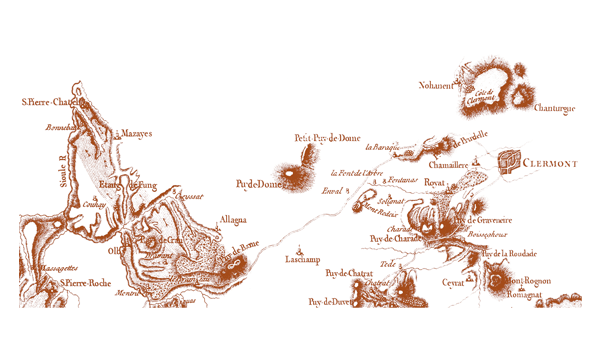An important scientific site
Date
from 1751 (identification of the landforms as being volcanic in origin by Jean-Etienne Guettard)
A founding site for volcanology
Many centuries went by before the volcanic origins of the Chaîne des Puys landforms were recognised. The study of these volcanoes in the 18th century laid the foundations for modern volcanology. Thus the area played a major role in the evolution of theories on volcano formation and the composition of their lavas.
As a result, a number of articles were written about the area in the 19th century, and great scientists such as the Frenchman N. Desmarest, the Englishman G.P. Scrope and the German L. Von Buch came to work in the area and develop new theories which underpin the current discipline of volcanology.

Extract from the first geological map of the Chaîne des Puys volcanoes, published by N. Desmarest in 1780
The Chaîne des Puys also played host to experiments and discoveries in other scientific areas such as physics and geomagnetism. Notably, Blaise Pascal carried out his well-known experiment on atmospheric pressure here in the 16th century.
A site of active scientific research
There is much current scientific work carried out on the site, mainly by the ‘Magmas et Volcans’ group at Clermont university, one of the most dynamic volcanology groups in the world. Through international collaborations with other researchers and the development of new techniques for studying volcanoes, this work has greatly contributed to the increase of scientific knowledge.
The Chaîne des Puys is one of the first places to pioneer new tools for use on active volcanoes worldwide, such as volcanic x-rays which enable the interior of an edifice to be observed. This method uses particles which penetrate the interior of the volcano to sound out the structure. This information can then be used to model the internal structure of the edifice.
An educational site
Due to its accessibility, the clear shapes of its landforms, and its compact nature, the Chaîne des Puys has become a highly valued educational site, visited by innumerable school groups each year. Tourist sites such as Vulcania and Lemptégy help disseminate geological knowledge in a fun way.
Did you know ? Even NASA is interested in the Chaîne des Puys. In its study of faults on Mercury it compares them with those on the Petit puy de Dôme, Lemptégy and the puy de Grosmanaux.







